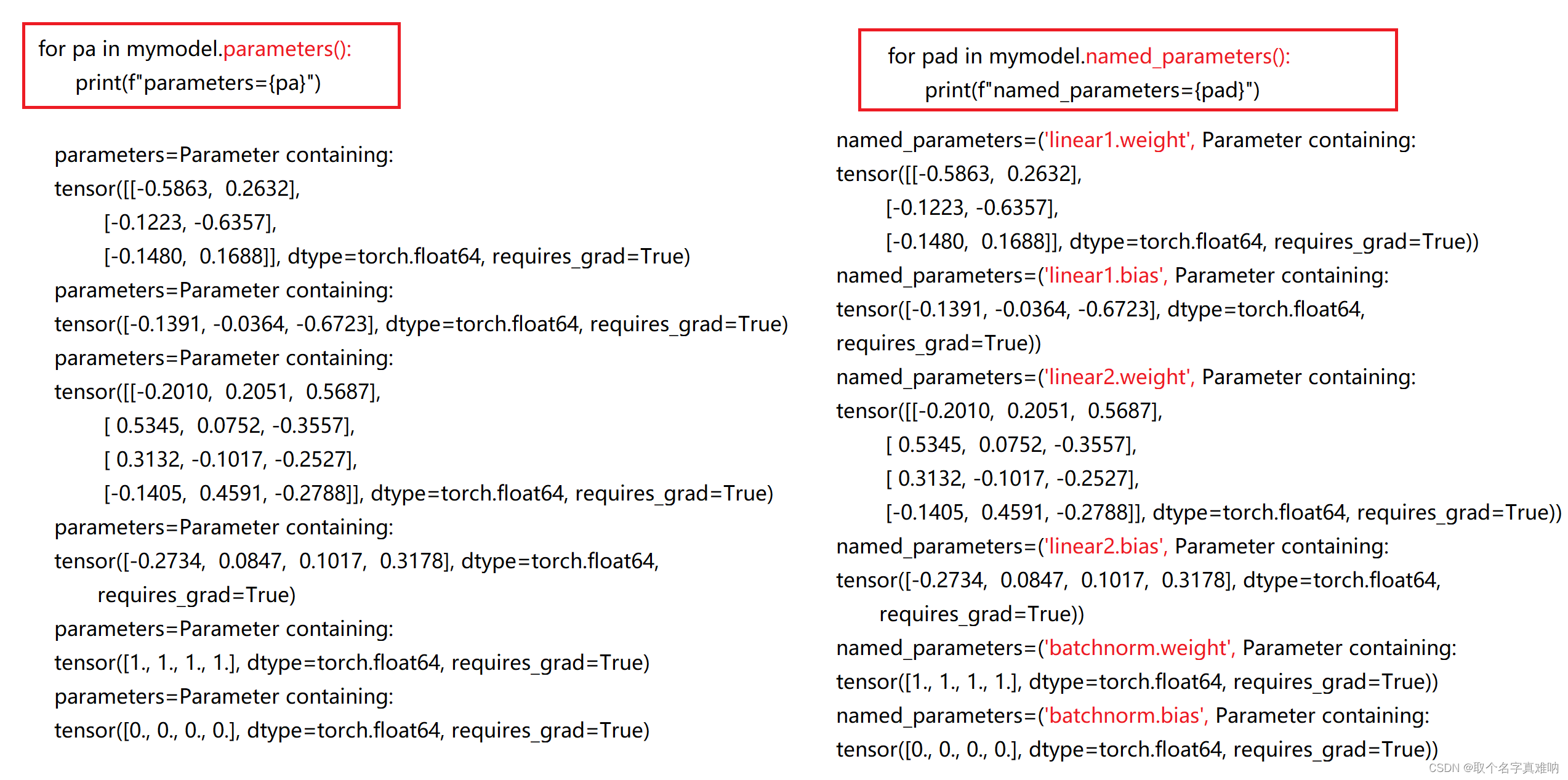文章目录
1. 模型的保存和加载 (权重保存-简易方法)
- 保存状态字典
import torch
from torch import nn
import torchvision.models as models
# 从torchvision中下载一个预训练的模型vgg16
mymodel = models.vgg16(pretrained=True)
# 保存模型的权重state_dict
torch.save(mymodel.state_dict(), "model_weights.pth")
- 创建一个需要加载模型的实例
# 创建一个新的实例,跟以前的模型一致
new_model = models.vgg16()
- 将保存好的权重加载到新的模型中
# 将保存好的权重加载到新的模型中
new_model.load_state_dict(torch.load("model_weights.pth"))
# 模型进入推理模式,会影响到dropout和batchnorm
new_model.eval()
2. 保存checkpoint
这种保存方式,不仅仅保存模型的权重,还会保存模型的其他参数
(1)导入所有必要的库来加载我们的数据
(2)定义并初始化神经网络
(3)初始化优化器
(4)保存常规检查点checkpoint
(5)加载常规检查点checkpoint
2.1 导入所有相关的库
import torch
import torch.nn as nn
import torch.optim as optim
from torch import functional as F
2.2 定义并初始化神经网络
# 定义神经网络
class Net(nn.Module):
def __init__(self):
super(Net, self).__init__()
self.conv1 = nn.Conv2d(3, 6, 5)
self.pool = nn.MaxPool2d(2, 2)
self.conv2 = nn.Conv2d(6, 16, 5)
self.fc1 = nn.Linear(16 * 5 * 5, 120)
self.fc2 = nn.Linear(120, 84)
self.fc3 = nn.Linear(84, 10)
def forward(self, x):
x = self.pool(F.relu(self.conv1(x)))
x = self.pool(F.relu(self.conv2(x)))
x = x.view(-1, 16 * 5 * 5)
x = F.relu(self.fc1(x))
x = F.relu(self.fc2(x))
x = self.fc3(x)
return x
# 实例化神经网络
net = Net()
2.3 初始化优化器
初始化优化器,并将神经网络的参数注入到优化器中,设置超参数
- lr :学习率 ;learning_rate
- momentum:动量
# 优化器的实例化及超参数的设置
optimizer = optim.SGD(net.parameters(), lr=0.001, momentum=0.9)
2.4 保存常规检查点checkpoint
# Additional information
# epoch 迭代次数设置
EPOCH = 5
# 模型
PATH = "model.pt"
# 损失值
LOSS = 0.4
# 逐个保存模型的相关参数
torch.save({
'epoch': EPOCH,
'model_state_dict': net.state_dict(),
'optimizer_state_dict': optimizer.state_dict(),
'loss': LOSS,
}, PATH)
2.5 加载常规检查点checkpoint
# 实例化模型
model = Net()
# 实例化优化器
optimizer = optim.SGD(net.parameters(), lr=0.001, momentum=0.9)
# 加载保存的model.pt
checkpoint = torch.load(PATH)
# 加载权重
model.load_state_dict(checkpoint['model_state_dict'])
# 加载优化器值
optimizer.load_state_dict(checkpoint['optimizer_state_dict'])
# 加载迭代次数epoch
epoch = checkpoint['epoch']
# 加载损失loss
loss = checkpoint['loss']
# 设置模型为推理模式
model.eval()
注:在运行推理之前,必须调用model.eval()将dropout和批处理规范化层设置为求值模式。如果不这样做,将产生不一致的推理结果。
3. to 操作
我们通过model.to(torch.double)可以将模型的参数类型进行更改
# 1.导入相关库
import torch
from torch import nn
# 2.定义模型
class MyTest(nn.Module):
def __init__(self):
super(MyTest, self).__init__()
self.linear1 = nn.Linear(2, 3)
self.linear2 = nn.Linear(3, 4)
self.batchnorm = nn.BatchNorm2d(4)
# 3.实例化神经网络
mymodel = MyTest()
# 4.打印出神经网络中linear1的权重参数类型linear1.weights.dtype = torch.float32
print(mymodel._modules["linear1"].weight.dtype)
# 5.将模型中的参数类型转换成torch.double
mymodel.to(torch.double)
# 6.打印出神经网络中linear1的权重参数类型linear1.weights.dtype = torch.float64
print(mymodel._modules["linear1"].weight.dtype)
# 转换成功 torch.float32 -> torch.float64
4. _parameters和parameters的区别
- _parameters:针对的是当前模型中是否有nn.parameters,跟子类无关
- parameters:不仅跟当前模型的parameters有关,还跟其子类的parameters有关
# 1.导入相关库
import torch
from torch import nn
# 2.定义模型
class MyTest(nn.Module):
def __init__(self):
super(MyTest, self).__init__()
self.linear1 = nn.Linear(2, 3)
self.linear2 = nn.Linear(3, 4)
self.batchnorm = nn.BatchNorm2d(4)
# 3.实例化神经网络
mymodel = MyTest()
# 4.打印出神经网络中linear1的权重参数类型linear1.weights.dtype = torch.float32
print(mymodel._modules["linear1"].weight.dtype)
# 5.将模型中的参数类型转换成torch.double
mymodel.to(torch.double)
# 6.打印出神经网络中linear1的权重参数类型linear1.weights.dtype = torch.float64
print(mymodel._modules["linear1"].weight.dtype)
# 转换成功 torch.float32 -> torch.float64
# _paramters 返回的是当前网络中是否有parameters,跟子模块的parameters无关
# 所以 mymodel._parameters=OrderedDict()
print(f"mymodel._parameters={mymodel._parameters}")
# 同理_buffers一致
print(f"mymodel._buffers={mymodel._buffers}")
# 逐个迭代模型中的参数
for pa in mymodel.parameters():
print(f"mymodel.parameters={pa}")
5. state_dict
- 作用: 保存模型的参数
def _save_to_state_dict(self, destination, prefix, keep_vars):
r"""Saves module state to `destination` dictionary, containing a state
of the module, but not its descendants. This is called on every
submodule in :meth:`~torch.nn.Module.state_dict`.
In rare cases, subclasses can achieve class-specific behavior by
overriding this method with custom logic.
Args:
destination (dict): a dict where state will be stored
prefix (str): the prefix for parameters and buffers used in this
module
"""
for name, param in self._parameters.items():
if param is not None:
destination[prefix + name] = param if keep_vars else param.detach()
for name, buf in self._buffers.items():
if buf is not None and name not in self._non_persistent_buffers_set:
destination[prefix + name] = buf if keep_vars else buf.detach()
# The user can pass an optional arbitrary mappable object to `state_dict`, in which case `state_dict` returns
# back that same object. But if they pass nothing, an `OrederedDict` is created and returned.
T_destination = TypeVar('T_destination', bound=Mapping[str, Tensor])
def state_dict(self, destination=None, prefix='', keep_vars=False):
r"""Returns a dictionary containing a whole state of the module.
Both parameters and persistent buffers (e.g. running averages) are
included. Keys are corresponding parameter and buffer names.
Returns:
dict:
a dictionary containing a whole state of the module
Example::
>>> module.state_dict().keys()
['bias', 'weight']
"""
if destination is None:
destination = OrderedDict()
destination._metadata = OrderedDict()
destination._metadata[prefix[:-1]] = local_metadata = dict(version=self._version)
# 遍历当前模型中模块的state_dict
self._save_to_state_dict(destination, prefix, keep_vars)
# 遍历子模型中模块的state_dict
for name, module in self._modules.items():
if module is not None:
module.state_dict(destination, prefix + name + '.', keep_vars=keep_vars)
for hook in self._state_dict_hooks.values():
hook_result = hook(self, destination, prefix, local_metadata)
if hook_result is not None:
destination = hook_result
return destination
- 案例代码
# 1.导入相关库
import torch
from torch import nn
# 2.定义模型
class MyTest(nn.Module):
def __init__(self):
super(MyTest, self).__init__()
self.linear1 = nn.Linear(2, 3)
self.linear2 = nn.Linear(3, 4)
self.batchnorm = nn.BatchNorm2d(4)
# 3.实例化神经网络
mymodel = MyTest()
print(f"mymodel.state_dict()={mymodel.state_dict()}")
- 输出结果
注:就是一个有序的字典,将所有子模块的参数保存下来
mymodel.state_dict()=OrderedDict([('linear1.weight', tensor([[ 0.2309, 0.1947],
[ 0.1572, -0.5997],
[ 0.4253, 0.1184]], dtype=torch.float64)), ('linear1.bias', tensor([ 0.0010, -0.1031, -0.2801], dtype=torch.float64)), ('linear2.weight', tensor([[-0.4427, 0.0356, 0.0527],
[-0.1414, 0.4508, 0.5320],
[ 0.3816, 0.3372, 0.3967],
[-0.1054, 0.1467, -0.5630]], dtype=torch.float64)), ('linear2.bias', tensor([ 0.3134, -0.3881, 0.2067, -0.1626], dtype=torch.float64)), ('batchnorm.weight', tensor([1., 1., 1., 1.], dtype=torch.float64)), ('batchnorm.bias', tensor([0., 0., 0., 0.], dtype=torch.float64)), ('batchnorm.running_mean', tensor([0., 0., 0., 0.], dtype=torch.float64)), ('batchnorm.running_var', tensor([1., 1., 1., 1.], dtype=torch.float64)), ('batchnorm.num_batches_tracked', tensor(0))])
6. parameters&named_parameters
parameters:返回参数的张量值named_parameters():返回参数的名称和张量值

# 1.导入相关库
import torch
from torch import nn
# 2.定义模型
class MyTest(nn.Module):
def __init__(self):
super(MyTest, self).__init__()
self.linear1 = nn.Linear(2, 3)
self.linear2 = nn.Linear(3, 4)
self.batchnorm = nn.BatchNorm2d(4)
# 3.实例化神经网络
mymodel = MyTest()
for pa in mymodel.parameters():
print(f"parameters={pa}")
for pad in mymodel.named_parameters():
print(f"named_parameters={pad}")
parameters=Parameter containing:
tensor([[ 0.3966, -0.1722],
[-0.6319, 0.4421],
[ 0.1774, 0.5560]], requires_grad=True)
parameters=Parameter containing:
tensor([ 0.6004, 0.4914, -0.6790], requires_grad=True)
parameters=Parameter containing:
tensor([[ 0.5584, 0.4561, 0.3161],
[-0.2900, 0.4303, 0.4115],
[ 0.4425, -0.1321, -0.1889],
[-0.4999, -0.3429, -0.2785]], requires_grad=True)
parameters=Parameter containing:
tensor([-0.4464, -0.3374, -0.0186, -0.1464], requires_grad=True)
parameters=Parameter containing:
tensor([1., 1., 1., 1.], requires_grad=True)
parameters=Parameter containing:
tensor([0., 0., 0., 0.], requires_grad=True)
named_parameters=('linear1.weight', Parameter containing:
tensor([[ 0.3966, -0.1722],
[-0.6319, 0.4421],
[ 0.1774, 0.5560]], requires_grad=True))
named_parameters=('linear1.bias', Parameter containing:
tensor([ 0.6004, 0.4914, -0.6790], requires_grad=True))
named_parameters=('linear2.weight', Parameter containing:
tensor([[ 0.5584, 0.4561, 0.3161],
[-0.2900, 0.4303, 0.4115],
[ 0.4425, -0.1321, -0.1889],
[-0.4999, -0.3429, -0.2785]], requires_grad=True))
named_parameters=('linear2.bias', Parameter containing:
tensor([-0.4464, -0.3374, -0.0186, -0.1464], requires_grad=True))
named_parameters=('batchnorm.weight', Parameter containing:
tensor([1., 1., 1., 1.], requires_grad=True))
named_parameters=('batchnorm.bias', Parameter containing:
tensor([0., 0., 0., 0.], requires_grad=True))
7. _modules&named_modules
_module:返回模型中的所有子模块named_modules:返回模型中的所有子模块和自身
# 1.导入相关库
import torch
from torch import nn
# 2.定义模型
class MyTest(nn.Module):
def __init__(self):
super(MyTest, self).__init__()
self.linear1 = nn.Linear(2, 3)
self.linear2 = nn.Linear(3, 4)
self.batchnorm = nn.BatchNorm2d(4)
# 3.实例化神经网络
mymodel = MyTest()
print(f"mymodel._modules={mymodel._modules}")
print("*" * 10)
for named_modules in mymodel.named_modules():
print(f"named_modules={named_modules}")
mymodel._modules=OrderedDict([('linear1', Linear(in_features=2, out_features=3, bias=True)), ('linear2', Linear(in_features=3, out_features=4, bias=True)), ('batchnorm', BatchNorm2d(4, eps=1e-05, momentum=0.1, affine=True, track_running_stats=True))])
**********
named_modules=('', MyTest(
(linear1): Linear(in_features=2, out_features=3, bias=True)
(linear2): Linear(in_features=3, out_features=4, bias=True)
(batchnorm): BatchNorm2d(4, eps=1e-05, momentum=0.1, affine=True, track_running_stats=True)
))
named_modules=('linear1', Linear(in_features=2, out_features=3, bias=True))
named_modules=('linear2', Linear(in_features=3, out_features=4, bias=True))
named_modules=('batchnorm', BatchNorm2d(4, eps=1e-05, momentum=0.1, affine=True, track_running_stats=True))